How Many Tie Downs Are Required For Cargo? [Updated 2023]
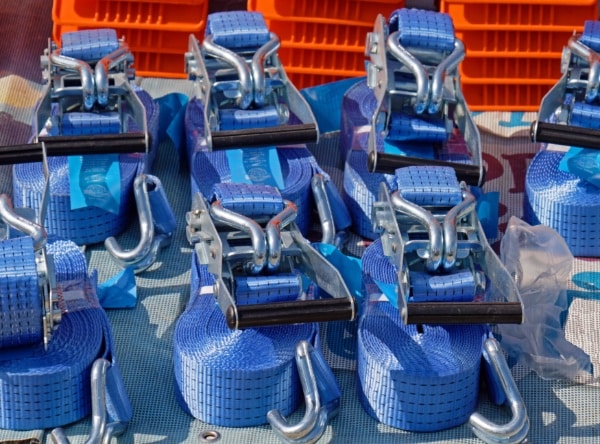
Tie-downs are an essential part of cargo transportation. Understanding FMCSA rules on working load limits, securing a tie down, and managing different types of cargo isn’t just essential for truckers. For Commercial Motor Vehicle drivers, it is critical to both their safety and to comply with the law.
Our guide explains everything you need to know about securing loads, choosing the proper tie-downs, and how to ensure you comply with FMCSA rules and stay safe on the road. We also offer a Cargo Securement Training Video, and you should check that out as well. We also have a write-up on cargo securement tips if you need those.
What is a Tie Down?
A tie down is a strap or cord used to secure cargo to a vehicle while in transit. This prevents the cargo from:
- Sliding around, potentially damaging it or other goods on board.
- Sliding to one side of the vehicle and potentially overbalancing it while turning a corner.
- Falling off the vehicle and causing a severe road traffic accident.
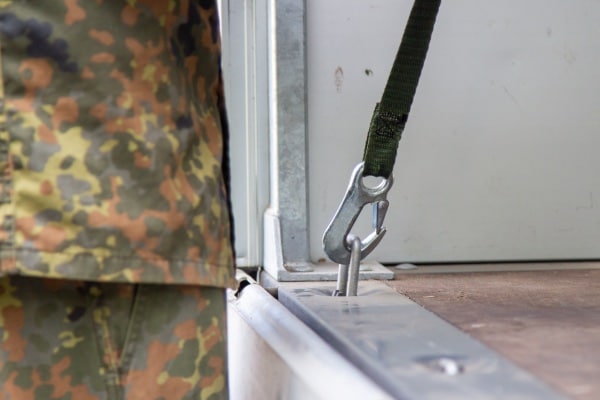
When Are They Used?
Tie-downs are used by fleet managers of professional cargo transport organizations but also by private individuals. Anyone driving commercial motor vehicles and transporting a substantial load should consider whether they need to use a tie-down to secure the load.
The best way to understand this is by considering:
- What type of cargo you’ll be transporting (is it large? Could it slide around? Is there a risk of it falling off the vehicle if not secured?)
- Where will you be transporting it, and what will the road surface be like? For example, a farmer moving cargo along a rough country track might decide to tie it down even if it might seem secure when driven on a regular road.
- What is the strap’s working load limit (WLL)? This measures how much weight can safely be held by a strap. In cases where one strap isn’t enough, two tie-downs can be used to secure larger cargo.
How Do They Work?
A tie-down is applied for cargo securement and is usually either synthetic webbing or a chain. Webbing is typically sold in 12-16ft lengths for smaller straps and 25-30 foot lengths for larger straps. These can be lashed to fit the cargo load, although greater lengths are available.
The “webbing” creates a net that won’t allow cargo to fall from the vehicle and/or move around where necessary. For this reason, the weight of the cargo isn’t directly proportional to the number of tie-downs you’ll need – a pile of boxes might need a mesh of ties to secure it in place, whereas several steel girders could be lashed to a flatbed trailer using just a few straps.
There’s an element of common sense about working out how many straps are needed for cargo securement, but we’ll cover this and the FMSCA rules below.
What Qualifies as a Tie Down?
Tie-downs are often sold as cord or wire rope, but there are several different types of straps permitted by the FMSCA (Federal Motor Carrier Safety Administration) and CVSA (Commercial Vehicle Safety Alliance).
Some of these are sold for purpose – this is generally an advantage, as you’ll have a clear idea of the strap’s working load limit. However, unmarked chains and other unmarked tie-downs are acceptable in most circumstances.
Below we outline the most common straps used to secure cargo to a truck or commercial vehicle.

Lashing Straps
Light-duty lashing straps are sometimes used on a small truck or vehicle transporting lightweight goods. They typically have a working load limit of around 100-200lbs and a break strength of 200-400lbs. We’ll cover the difference between break strength and WLL later.
These aren’t appropriate for heavy-duty cargo securement but are an affordable and accessible choice for private individuals looking to move goods. For example, you might use a lashing strap to secure a fridge in the back of a pickup truck. One half of the “net” could prevent it from moving left to right; one half could prevent it from moving forwards or backward.
Tarp Straps
These are another choice for light loads. Tarp straps are popular for holding a tarp down when it covers goods. They’re designed as bungees and rarely have a WLL of more than 100lbs. They’re mainly used for camping trips and private use.
Ratchet Straps
There are several types of ratchet straps – generally, you’ll find 1-4 inch ratchet straps on sale. The difference in working load limit (WLL) tends to be as follows. Note that exact WLL and breakpoint limits depend on the manufacturer, and you should always check the rating on the straps you’re using:
- 1-inch: these are usually rated for a WLL of 500-1,100lbs. They’re useful for light trucks and moving vans, as they’re generally much more powerful than lashing straps.
- 2-inch: these have a rating of around 900-3,300lbs. They’re useful for transporting one or more articles and are also a popular choice for moving vehicles, e.g., a road rescue service might use them.
- 3-inch: these are heavy-duty cables with a WLL of around 5,000lbs. They’re designed for flatbed trailers and extremely heavy items. Due to the size of the ratchet, these aren’t typically used for smaller trucks or private vehicles. They can’t be secured properly due to a lack of suitable anchor points and might damage the vehicle.
- 4-inch: these are generally used for cargo that requires a WWL of several tons. It’s likely that if you need to use a 4-inch ratchet strap, there will be more detailed requirements for the type of heavy equipment you’re transporting – we cover these further down the page.
Ratchet straps are among the most popular ways of securing cargo as they’re very strong and often more affordable than a chain.
Cam Buckle Straps
This is somewhat like a tarp strap but tends to have a higher working load limit. Cam buckle straps often have a WLL of around 500lbs maximum.
Wire Rope
This is a strengthened steel wire cable. It’s typically used for transporting heavy equipment – the rope’s strength varies dramatically depending on its thickness. WWL is calculated based on the diameter of the rope.
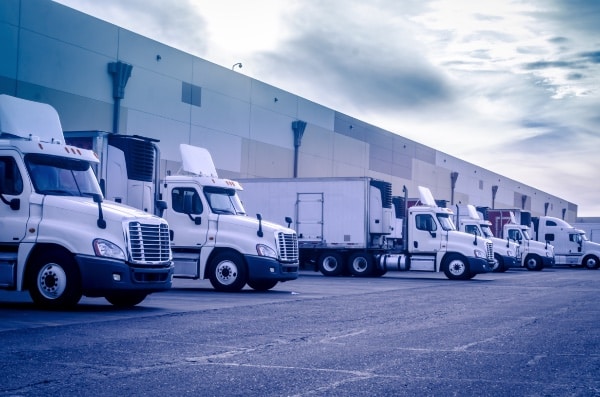
Coil Chain
Coil chain is the most commonly used cargo securement material for super-heavy loads, such as logs or securing freight containers. There are several grades of chain used for cargo securement.
We won’t give a rough WWL for these systems as it depends too much on the size of the chain; for example, a grade 30 chain can have a WWL as low as 400lbs or as high as almost 18,000lbs. However, these are the key differences and uses of each chain type.
- Grade 30 chain (proof coil): this is the most basic type of coil chain. It’s often used for transporting concrete beams or other heavy equipment.
- Grade 43 chain (high test): this chain is far stronger and is often used for logging.
- Grade 70 chain (transport): this is the strongest chain regularly used by fleet managers. It’s extremely powerful and has a maximum WWL equal to almost any load a flatbed truck could transport. However, it’s less expensive than the alloy chain options noted below.
- Grade 80 & 100 chains (alloy): these are rarely used except for abnormal loads, as alloy chain is costly to produce and use. This chain type is often employed for overhead lifting equipment, e.g. crane booms. It’s also used for fabricated structural items. Grade 100 is somewhat stronger than grade 80.
Unmarked Welded Chain
If you have a welded chain tie-down, but there’s no indication of its WWL, it’s considered a grade 30-proof coil. When transporting heavy equipment, the supplier and/or freight company should consult a table of working load limits to understand whether grade 30 coil is sufficient to transport the equipment in question.
Other Unmarked Tie Downs
Likewise, unmarked webbing and other straps are considered the lowest strength that matches their description when you refer to a table of working load limits. These tables can be obtained from occupational safety course providers and online.
Fastening Types
The type of fastening you use with a tie-down depends on the load you’re transporting and the vehicle used. Light trucks require edge protection that doesn’t work with heavy-duty hooks or plates. You must find a safe anchor point where the strap or chain must be secured.
Below we list some common types of hook or plate attachment.
S-Hook
These are commonly used on a tarp strap or a light ratchet strap. They’re easy to attach to light vehicles, making them popular for small trucks and moving companies.
A disadvantage is that an S-hook is prone to sliding unless held securely.
J-Hook
These are typically used with ratchet straps. They usually have a double end forming the curve of a J – this helps them hold in place more effectively than S-hooks.
Snap Hook
A snap hook has a closing latch that holds the hook in place. Small snap hooks are very popular for lighter vehicles as they attach easily to anchor points around the truck.
Flat Hook
These are specifically designed for trucks, as the hook makes an almost 180-degree loop that fits neatly over the rear rail of a truck. These can also be attached to other ratchet cables in some cases.
Ring Plate
A ring plate can be attached to a truck to create an additional anchor point for hooks to connect to. The ring plate is bolted on, creating an anchor that hooks can be adequately secured to.
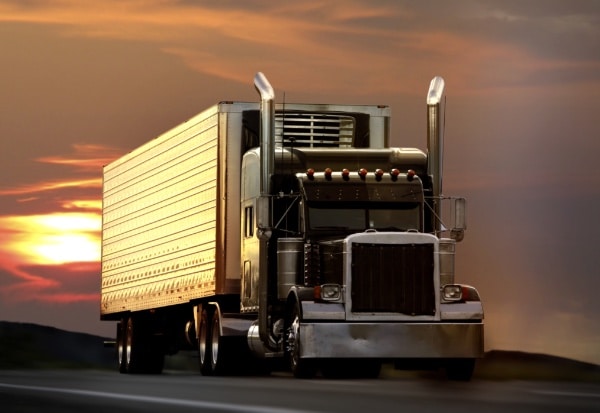
What Role Do Tie Downs Serve in a Cargo Securement System?
Tie-downs are one of the most important features of a cargo securement system. Oversized cargo and heavy equipment are often much easier to move using open-back trucks than in freight containers – think of processed logs or heavy vehicles.
Motor carriers, logging trucks, and large cargo vehicles rely on direct tie-downs to safely transport their cargo across the country.
An advantage of tie-downs is that they rely on hooks for cargo securement. Whether it’s a strap or metal coils, once the cable is slackened off, it’s quick and easy to remove the tie-downs and allow the cargo to be unloaded. This makes transit much quicker and easier than, for example, if securing cables had to be unbolted or unlocked.
The ultimate goal is to prevent movement. Any items loaded onto the truck should be secure, and the fastenings used should support their total weight according to the WWL of the chain or strap.
Let’s now turn to the difference between working load limit and break strength – this is vital for safe transportation and following FMCSA rules.
What is a Tie Down’s Working Load Limit vs. Its Break Strength?
Regarding how much weight a tie-down can carry, there are two factors: the working load limit and the break strength.
The WLL is generally calculated as 1/3 of the break strength, meaning that a tie-down with a break strength of 20,000lbs would be rated as having a WLL of ~6,660.
Working Load Limit
This is the measure used to calculate how much weight a tie-down should carry. The WLL accounts for variables like:
- The fact that the vehicle is moving
- Sharp turns the vehicle might need to make
- Bumpy surfaces
- Emergency stops
The weight of the cargo must never exceed the WLL. It’s important that drivers submit to and understand FMSCA safety rules in this area and don’t consider the break strength to be the “actual” weight limit of the tie-down.
Break Strength
Break strength indicates how much weight is needed to snap a tie-down when no additional force is applied (e.g. emergency stops when traveling at 60mph).
It’s important to note that there’s no “single” measure of break strength for a cargo securement system. Instead, each component has a designated break strength, and the WWL is calculated using the lowest of these.
For example, the anchor point on a vehicle might have a break strength of 10,000lbs. The strapping used as a tie-down has a break strength of 6,000lbs.
However, if the hook used to connect the strap to the vehicle has a break strength of only 1,500lbs, then that’s the measurement used to calculate the WWL – so the system would have a WWL of 500lbs.
This is one reason that chains are often preferred to webbing systems. Chains can connect directly to the vehicle’s anchor points, meaning there are only two variables to consider when calculating WWL. Of course, chains also boast much higher break strength than synthetic materials.
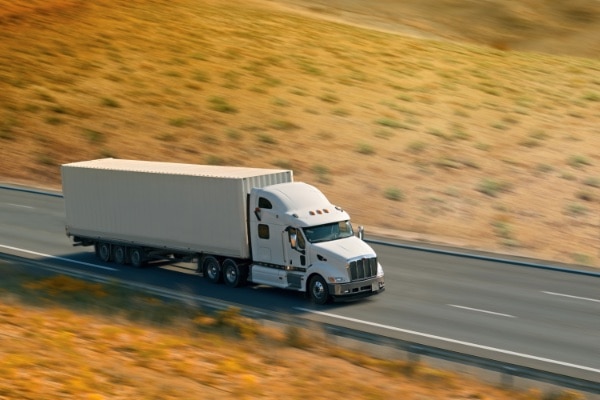
So How Many Straps Do You Need on a Load?
What is the minimum number of tie-downs needed to transport goods? As mentioned earlier, this partly depends on how the vehicle is loaded – there’s an element of common sense besides the rules.
If you’re following safety rules, but you see that there’s a chance that equipment will slip through the tie-downs during transportation, you need another chain or strap. Simple.
Below we’ll outline the rules that the FMCSA requires that drivers submit to when loading equipment or goods onto a vehicle.
Some types of cargo and equipment (such as motor carriers) are covered by a special rule unique to that type of transport – we’ll go into more details on that below.
Articles Requiring 1 Strap
For just one tie-down to be necessary:
- The article length must be no more than 5ft.
- The total weight of the article must be no more than 1,100lbs.
A good example of this would be a fridge or a washing machine. This could be secured on a light vehicle using a cam-buckle strap, provided its WWL was greater than the item’s weight.
Articles Requiring 2 Straps
Federal regulations note that you must use two tie-downs if:
- The item length is between 5ft and 10ft.
- The weight is greater than 1,100lbs.
Note that an item weighing over 1,100lbs but less than 5ft in length would still require two tie-downs. Likewise, a 9ft item that weighed just 50lbs would require two cables. Both criteria must be met if you want to use just one tie-down.
Articles Requiring 3+ Straps
The Federal Motor Carrier Safety Administration (FMCSA) rules state that additional tie-downs must be used for every 10ft (or a fraction thereof) that the article extends beyond the initial 10ft required to use two tie-downs.
This means that a 10′ 1″ item requires three tie-downs, a 20′ 1″ item requires 4, etc.
Once again – more can be applied, especially when transporting heavy equipment! As well as preventing cargo from falling sideways or backward off the vehicle, it’s vital to have a secure system in place to prevent the cargo from shifting in a forward direction if the vehicle brakes suddenly.
This would damage the front-end structure of the vehicle, compromising the driver’s safety. It could easily lead to a fatal accident.
Tie Downs for Blocked Articles
Articles are considered “blocked” if there is no conceivable way that they could move in the forward direction or any other during transportation. In this case, no tie-downs are required to keep the load in place.
Transporting Multiple Articles
If transporting multiple heavy articles (such as cars), tie-downs should be applied independently to each unit. 2 x 6ft automobiles weighing 1,200lbs each would require a minimum of 2 tie-downs.
Measures should also be taken to ensure that heavy cargo won’t clash “within” the cargo securement area; e.g. tie-downs could be used to ensure that there’s no risk of cars sliding and bumping even if there’s no risk of them falling onto the road.
Tie Downs for Special Purpose Vehicles
Some vehicles need special cargo securement arrangements due to their abnormal load. So how many tie-downs should you use when hauling heavy equipment?
Most of the categories below have industry-standard rules that can be found by checking the FMCSA website and searching for the given load type. However, there are some exceptions where general cargo rules apply, which means the rules around tie-downs listed above are also applicable.
We cover these safety rules for various types of unique cargo securement below.
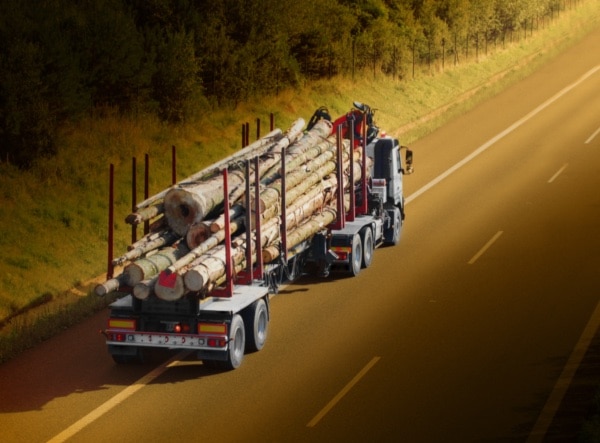
Logs
Special methods are required to transport large volumes of loose logs. There are some exceptions. However – the rules on tie-downs listed above may apply when:
- The logs are banded to form a single unit.
- The load consists of a maximum of 4 processed logs.
- Log debris may be transported in an enclosed container.
Dressed Lumber
Individual units of dressed lumber must be treated as items and secured accordingly unless they’re banded together. In this case, they must be secured following the rules for a single unit of cargo meeting.
Metal Coils
Metal coils can be transported using the above rules if their total weight is 5,000lbs or less. If it exceeds this, they must be transported according to specific rules for this cargo type.
Paper Rolls
Likewise, paper roll shipments can be shipped using the rules above if they weigh less than 5,000lbs combined and are shipped appropriately (e.g. on a palette). Otherwise, specific regulations for paper roll transportation must be followed.
Concrete Pipe
Concrete pipe must be secured per the general cargo securement rules. Units bound together must not have any chance of rolling, and if they’re shipped inside a container, the container must be strong enough to withstand any internal movement.
This should also be secured to prevent rolling where possible.
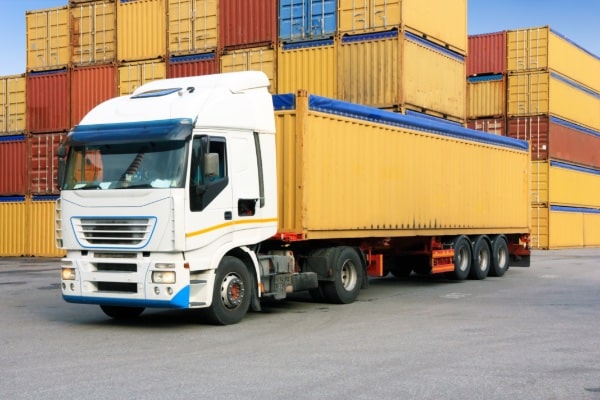
Intermodal Containers
Intermodal containers must abide by the rules for this type of container and the various vehicles used to transport it. Items or equipment within the containers should be secured according to the general regulations listed above.
Automobiles and Small Vans
Safety regulations are in place for transporting automobiles, vans, and commercial motor vehicles weighing less than 10,000lbs. These should be secured using appropriate binding (e.g. avoiding chains where they would scratch the surface).
Special rules for motor carriers may apply.
Heavy Equipment & Vehicles
Vehicles or heavy equipment that weighs more than 10,000lbs per unit must be transported according to specific rules. The general regulations for tie-downs and other equipment do not apply.
Crushed Vehicles
There are three types of crushed vehicle regulations:
- Deliberately crushed vehicles. These have specific rules that are applied when being transported as scrap.
- Accidentally crushed vehicles. These are subject to different requirements due to accidental vehicle destruction’s unique and sensitive nature.
- Accidentally damaged vehicles. If transported to a garage for repairs etc., these can be transported according to the general load requirements.
Roll-on and Hook Lift Containers
These specialized containers have unique regulations, along with any equipment loaded in them. General regulations do not cover them.
Large Boulders
Natural boulders weighing more than 11,000lbs has a unique set of transportation requirements.
If a boulder weighs between 200lbs-11,000lbs and measures less than two cubic meters, it may be loaded onto a vehicle and tied down, provided the vehicle is well-designed to contain the rock and it can be tied down appropriately.
Enforcement of Tie Down Regulations
Federal regulations on how equipment should be tied down are in place and are enforced by the FMCSA. The CVSA (Commercial Vehicle Safety Alliance) offers advice and guidance on safely transporting cargo and heavy equipment.
If a load is seen improperly tied down while a vehicle is moving, someone will likely alert the authorities as it poses a clear danger to other motorists. It also poses a risk to the driver if a load isn’t secured properly, as the front-end structure of the vehicle could be hit if the emergency brake is used, or the vehicle could overbalance.

Penalties for Improper Transportation of Cargo
If you’re transporting cargo in a smaller vehicle, what kind of penalties could you face for not using tie-downs properly? How many tie-downs should cargo be held with CDL? It depends on:
- The length of the item in question. If the length is less than 5ft, one tie-down may be used as long as it doesn’t exceed 1,100lbs. 5-10ft requires two tie-downs, and then a further tie-down is required for every 10ft after that (where 10′ 1″ requires three tie-downs).
- Length is only one-half of the question – an item weighing more than 1,100lbs must always have at least two tie-downs for safety reasons. A chain is generally a stronger way to hold heavy equipment, although chains can be expensive for private individuals.
Failure to abide by these safety rules can lead to significant fines from federal bodies and local authorities.
Staying Safe
The best practice is always to fasten equipment and other accessories not just so that you meet the regulations but so that you’re 100% confident they won’t move when you’re transporting them.
This applies equally to private citizens and nationwide freight companies – road safety is for everyone. Cargo safety is no different.
Summary
Whether you fasten your cargo in place using synthetic webbing or powerful chains, you need to ensure that the WWL is appropriate for your load. You need to check additional regulations if you’re transporting a special load. And you need to take a critical look at your work before you set off and confirm that you’re confident you’re driving safely. Hopefully, this information has helped you to understand how many tie-downs it takes to secure a load.